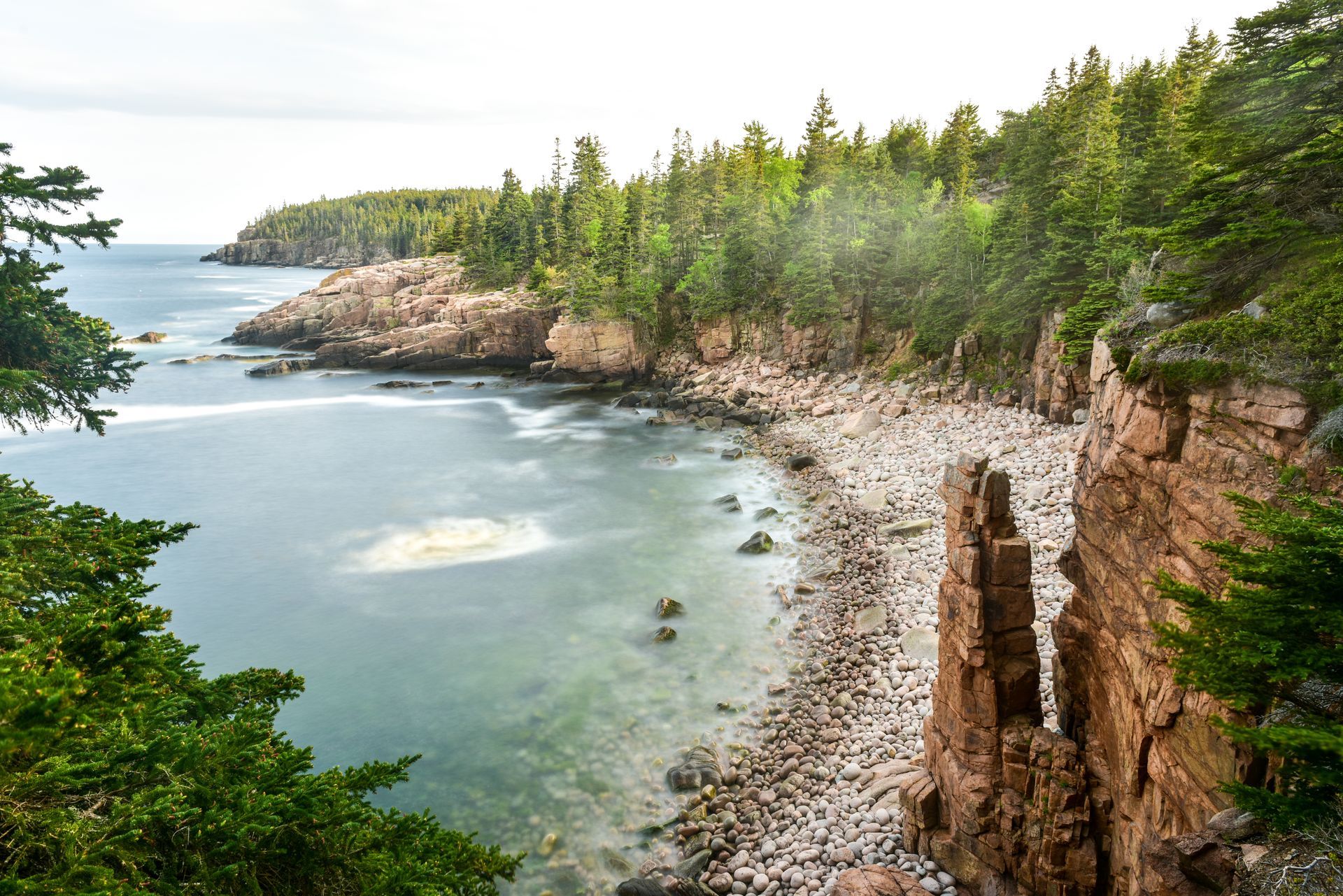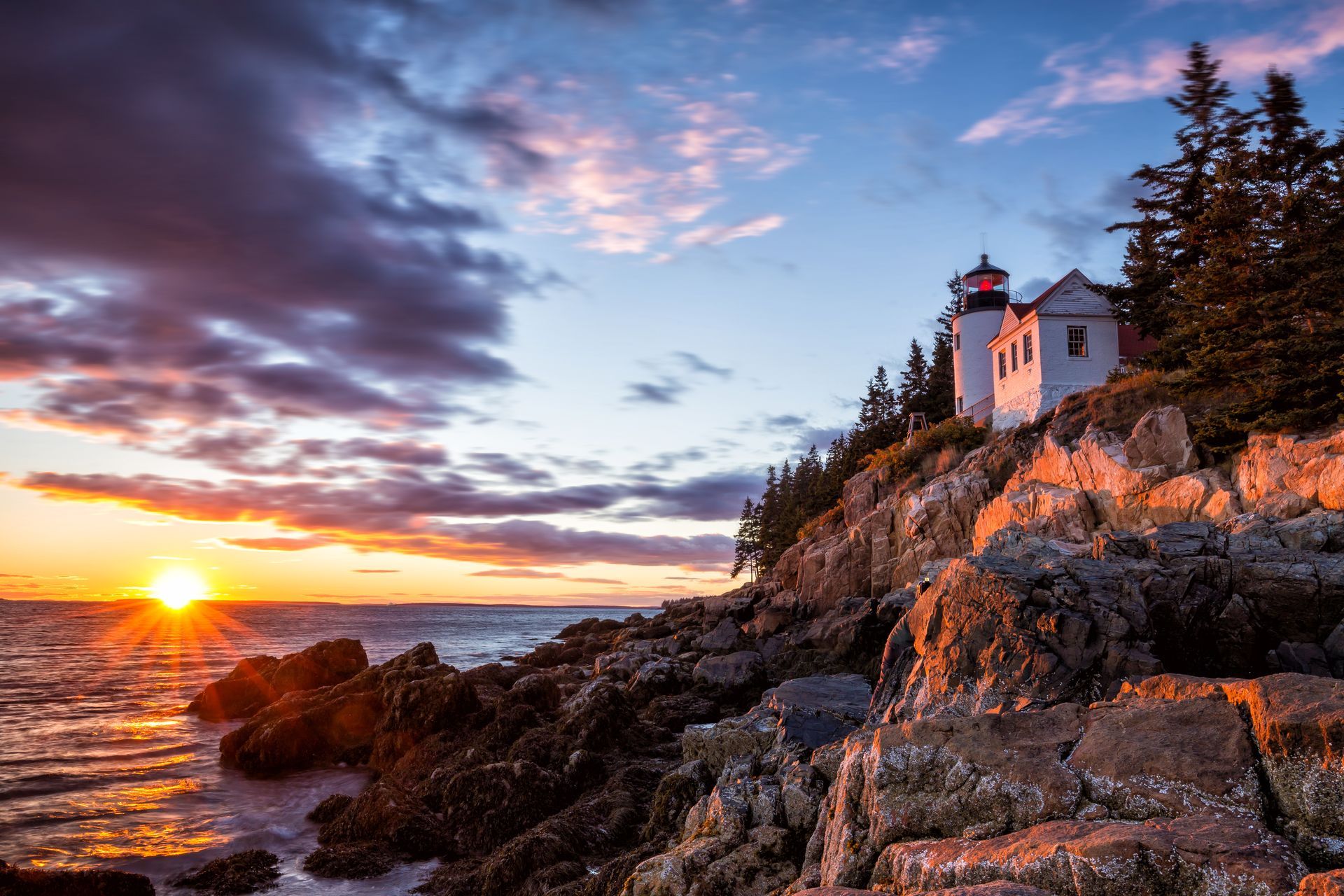The Ultimate Acadia National Park Guide
If you’re craving a getaway where rugged coastlines meet wind-swept peaks, Acadia National Park should be at the top of your list. Located on the rocky shores of Maine, this Atlantic-side national park offers a refreshing mix of scenic drives, dramatic sunrises, and trails that range from “let’s take a stroll” to “should’ve stretched first.”
This guide has the answers you’re Googling, whether it’s how to get there, where to hike, or if the Seawall is an actual wall (spoiler: it’s not). Let’s get into it.

What Makes Acadia Special?
Acadia stands out because it packs dramatic coastal cliffs, alpine peaks, quiet lakes, and dense forest into a relatively compact scenic park. You can hike a granite ridge in the morning, spot harbor seals at lunch, and watch the sun dip below the Atlantic after dinner.
Few places offer this kind of terrain variety without requiring a passport or a week of travel time. It's also one of the few national parks where you can summit a mountain and then grab fresh lobster 20 minutes later. That’s a pretty unbeatable combo.
Getting There: Airports and Road Trips
No matter where you’re coming from, the trip to Acadia is worth it. Here are some helpful tips as you plan your trip:
What is the Nearest Airport to Acadia National Park?
The closest airport is Hancock County–Bar Harbor Airport (BHB), just 10 miles from the park. It’s tiny, but convenient if you’re flying from Boston or select East Coast hubs. For more flight options, Bangor International Airport (BGR) is about 50 miles away and handles more traffic.
Boston to Acadia National Park
Driving from Boston to Acadia is a solid 5-hour trip (around 280 miles), depending on traffic and your tolerance for roadside lobster rolls. Take I-95 north through Portland and Bangor before merging onto Route 1A and heading toward Mount Desert Island. It’s scenic, especially once you hit the coastal stretches.
Portland to Acadia National Park
From Portland, you’re looking at about a 3-hour drive (170 miles). If you’re into lighthouses and seafood shacks, consider taking the slower but more picturesque U.S. Route 1. Otherwise, I-295 to I-95 is faster.
Top-Rated Hiking Trails
There are over
150 miles of trails in Acadia, and we think these four deserve a spot on your shortlist:
- Cadillac Mountain Summit Trail: This 3.5-mile round-trip hike gains 1,300 feet of elevation and gives you those sunrise bragging rights. Or drive up if you'd rather earn the view via gas pedal.
- Beehive Loop: Not for the faint of heart or the vertigo-prone. This 1.5-mile trail includes iron rungs, exposed cliffs, and serious views over Sand Beach. Skip it if it’s wet.
- Jordan Pond Pat: A gentle, 3.4-mile loop around one of the park’s most photogenic lakes. Flat terrain and wide paths make it ideal for relaxed walkers.
- Ocean Pat: This 4-mile round-trip trail runs parallel to the Park Loop Road, serving constant Atlantic views with minimal elevation gain.

Wildlife You Might Spot
Acadia is home to an array of critters, just don’t share your granola bar with any of them.
- White-tailed deer are common and photogenic.
- Peregrine falcons nest on cliffs and make quite a dive show.
- Harbor seals pop their heads above the surf if you’re watching closely.
- Red foxes occasionally dart across trails like bushy-tailed phantoms.
Bring binoculars, but keep a respectful distance. Wildlife selfies are not a great idea.
Cadillac Mountain is famous for sunrise views. For part of the year, it’s the
first spot in the U.S. to see the sun. Naturally, it gets crowded, but is still worth the hike.
Other solid sunrise locations:
- Schooner Head Overlook
- Ocean Path near Thunder Hole
- Great Head Trail
Timing depends on the season—expect to be up before 5 a.m. in midsummer if you want a front-row experience.
Best Spots for Sunrise
What to Know About the Seawall
The Seawall is a naturally occurring granite and cobblestone barrier on the southwestern edge of Mount Desert Island. It’s not an actual wall, but it’s a fantastic spot for a quieter coastal experience.
Visitors come here for:
- Tidepooling at low tide
- Breezy picnic areas
- Easy shoreline strolls
It’s less busy than Sand Beach or Thunder Hole, and the ocean soundtrack is top-notch.
Each season in Acadia offers a unique atmosphere. Here’s what to expect depending on when you visit:
- Summer (June–August): Highs in the 70s, perfect for hiking, biking, and boat tours. Crowds are to be expected, as this is one of the best times to visit.
- Fall (September–October): This is Acadia showing off. Foliage explodes in golds and reds, with cool, crisp air and thinner crowds.
- Spring (April–May): Wet, muddy, but still beautiful. Trails can be slick, but wildflowers begin to bloom.
- Winter (November–March): Snowshoeing and cross-country skiing take over. Many roads close, and park access becomes limited—but the silence is unmatched.
Pro tip: Always bring layers. Weather on the coast changes quickly.
When to Visit: Seasons & Weather
If you’re new to national parks or just like a knowledgeable guide, tours are a great way to experience Acadia. Options include:
- Boat tours: Puffin spotting, lighthouse cruises, and harbor tours
- Ranger-led hikes and talks: Free with park admission, these are rich in natural and cultural history
- Private van or bike tours: For a deeper dive without the legwork
If you’d rather explore solo, the park’s visitor centers (Hull’s Cove and Thompson Island) offer plenty of resources to get you oriented.
Acadia National Park Tours: Worth It?
You’ll need an entrance pass to visit Acadia. Here's the breakdown:
- Private vehicle (7-day pass): $35
- Per person (no vehicle): $20
- Annual Acadia Pass: $70
- America the Beautiful Pass: $80 – good for all U.S. national parks for one year
Buy online at Recreation.gov, in person at the park entrance stations, or at various retailers in Bar Harbor.
National Park Pass: What You Need
A few final things to know as you plan your vacation:
- Cell signal: Spotty at best. Download maps in advance.
- Leave no trace: Pack it in, pack it out. Yes, even that banana peel.
- Parking: Arrive early or use the Island Explorer shuttle system (it’s free and reduces congestion).
- Apps: Download the NPS app and AllTrails for offline maps and trail info.
Final Tips Before You Go
Stay at Eden Village Motel & Cottages
You could rough it in a tent, or you could stay somewhere that will give you a good night’s sleep. For those who appreciate a clean bed, a quiet setting, and space to unwind after a day of hiking or climbing iron rungs, check out Eden Village Motel & Cottages. Located just minutes from the park entrance, it offers a peaceful retreat without sacrificing access.
Book your stay at Eden Village Motel & Cottages, and start counting down the days until your Acadia adventure begins.

